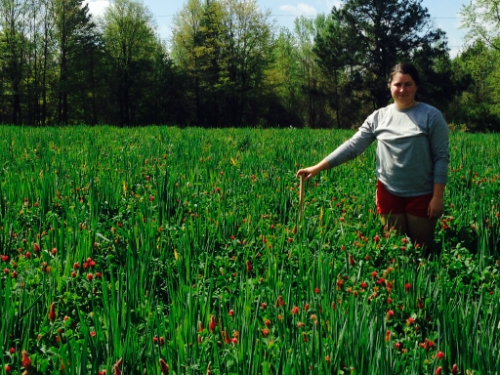Cover Crop Mixtures

Quick Look:
- Soil health. Cover crop mixtures may increase microbial community diversity, but research in agricultural production systems in the Southern region is limited. A diverse microbial community may help increase soil carbon, solubilize micronutrients, decrease populations of pathogens, including harmful nematodes, and increase plant resilience to extreme weather events.
- Functions. Cover crop mixtures can provide several functions including increasing organic matter, feeding microbes, suppressing plant pathogenic nematode populations, fixing nitrogen, suppressing weeds, as well as providing habitat/food for beneficial insects and pollinators. There are tradeoffs and mixtures may not maximize any particular function.
- Species selection. Select cover crops based on when you will not be growing cash crops, species that grow well during that window, your goals for the cover crop, as well as to minimize pest and disease problems. Brassica cover crops can serve as a disease bridge to brassica cash crops and are generally not recommended for vegetable production. Legumes can also host many vegetable pathogens, so should be used carefully in a vegetable rotation.
- Seeding rates. Exact seeding rates are difficult to recommend. For a grain/legume mixture, using 1/3 the grain seeding rate to 2/3 the legume rate has worked well. A simple method for mixtures with three or more species is to divide the divide the seeding rate for each species by the number of species in the mixture.
- Termination by mowing and incorporation. Most vegetable producers mow and incorporate the cover crop. Cover crops should be incorporated at least three weeks before planting the cash crop.
- Termination by mowing and leaving residue on the surface. Some vegetable producers mow cover crops and leave them as a surface mulch to inhibit weeds. Most cover crops can be terminated by mowing after these begin to flower. A mixture with varieties that have similar maturity dates will help provide a good kill. Wait until the mulch is brown to transplant the cash crop.
- Termination with rolling and crimping. A mixture with varieties that have similar maturity dates will help provide a good kill with roller/crimpers. Roll and crimp twice in the same direction, separated by 2-3 days for best results. Best termination with roller/crimpers is obtained at soft dough stage with grains and at mid-bloom with legumes.
- Termination with herbicides. Glyphosate alone will not terminate most mixtures. Vegetables are very sensitive to herbicide residuals. Consider herbicide residuals and consult your local Extension.
- Yields. Most data indicate it may take many years of integrating a cover crop into a vegetable production system before there is a response in cash crop yields. Most growers use cover crops to enhance ecosystem services and to potentially reduce input use or enhance efficiency of inputs used, while maintaining crop yields.
- Costs. Although mixtures can be more expensive than single species, with careful thought you can create a mixture that is cost effective.
Soil Health
Interest in cover crop mixtures has been increasing and is, driven by a desire to mimic natural ecosystems such as a prairie. In many natural ecosystems, there is high biodiversity in vegetation that contributes to the stability of the ecosystem. Agro-ecosystems have much less biodiversity. Planting a mixture of covers crops increases the biodiversity of farming systems, which can increase soil health and other benefits a cover crop can provide.
The different species in a cover crop mixture have different root structures. These access different areas in the soil and release a variety of substances (root exudates) that microbes use as food. The assumption is if there are many different types of plants with different root exudates and structures, there will be a more diverse microbial community that will increase soil carbon, solubilize nutrients such as phosphorus, resist pathogens and be resilient to disturbance. There is research to support this assumption, but most of it has not been conducted in the soils and climate of the Southern United States.
Functions
Cover crop mixtures can provide a variety of benefits. One of the most important for vegetable producers is providing habitat for both beneficial insects and pollinators. This is an important benefit of both winter and summer cover crop mixtures. Another benefit is building soil organic matter, which helps to repair or maintain soil structure that is often destroyed with the intensive tillage in most vegetable production systems. Providing nitrogen for the following cash crop can also be important, particularly for organic vegetable production. Grain/legume mixtures work well to provide a slow-release nitrogen for many vegetable crops. While cover crop mixtures can provide several benefits, these may not maximize any one benefit. Whether or not a mixture is right for your operation will depend on the benefits you want the cover crop to provide.
Species Selection
Species and variety selection of cover crops in vegetable production is particularly important. You should select cover crops based on when the cover crops will be grown. For example, many vegetables producers have a “window” for cover crops in the winter months when they are not growing cash crops. Some producers may also have a window in the late summer before fall cash crops are planted. You should also select cover crop species that will meet your grow well within the time in your production system. You should also pick species that will provide the benefits you want for your particular situation. Information on cover crop benefits by species can be found here. Finally, you should be thinking about potential disease problems. The plant families in your cover crop mixture need to fit within your cash crop rotation. Rotation of plant families is a good practice to avoid carryover of some disease and insect problems. For example, winter brassica and legume cover crops could provide a bridge for the fungal pathogen Sclerotinia (white mold of various crops) to later spring cash crops such as lettuce and brassica vegetables. Summer legumes may be hosts for Sclerotium rolfsii (southern blight) and should be avoided in sites with a history of severe southern blight outbreaks.
One of the major disease problems for all vegetable growers in the southeast is the damage caused by root knot nematode (RKN) feeding. Most vegetables are hosts for RKN and populations will build up quickly when susceptible vegetables are grown non-stop. The use of nematode resistant cover crops is an essential tool in breaking the RKN life cycle and keeping populations low. Most grass cover crops are resistant to RKN. Some summer cover crops such as sunn hemp and sorghum-sudangrass will also suppress RKN populations. Only some varieties of cow peas and crimson clover are resistant. If RKN is a problem, care should be taken in selecting resistant cover crop varieties for use in cover crop mixtures. More information can be found in the additional resources section.
Seeding Rates
Exact seeding rates are difficult to recommend because the optimal seeding rates for different goals and production systems will be different. You will have to experiment to determine the right seeding rates for your situation. One thing to consider is soil fertility. In high nitrogen soils, grains will outcompete legumes and may completely dominate a mixture. In this case, the seeding rate for the grains should be reduced drastically. A seeding rate that has worked well for many farmers using a grain/legume mixture is reducing the grain seeding rate to 1/3 of the recommended rate and reducing the legume rate to 2/3 of the legume seeding rate. A simple method for mixtures with three or more species is to divide the divide the seeding rate for each species by the number of species in the mixture. This should just be used as a starting point.
Termination
Termination of complex mixtures can present challenges. When designing a cover crop mixture for your farm, should think carefully about the window of time you have to grow the cover crop, terminate it and get the field ready to plant. When selecting cover crop varieties for mixtures, try to select varieties that mature at a similar time. This will help prevent having one species setting viable seeds before you are ready to terminate the cover crop mixture.
Most vegetable producers terminate their cover crops by mowing them and then incorporate the residue. The cover crop should be mowed and incorporated at least three weeks before planting a cash crop to ensure the residue has time to adequately break down.
Some vegetable producers mow cover crops and leave the residue on the surface as a mulch. Mowing will kill many cover crop species if these have begun to flower (reached the reproductive stage). Mowing grass or grain cover crop species will not kill them before these have reached a reproductive stage. Selecting varieties with similar maturity dates can help reduce this problem in cover crop mixtures. Wait to transplant cash crops until the mulch has dried and is brown to reduce insect and disease pressure.
Rolling and crimping cover crop mixtures can work but can be difficult. Rolling and crimping cover crops works best when the cover crop species is blooming or just before the seeds are viable. Best termination with roller/crimpers is obtained at soft dough stage with grains and at mid-bloom with legumes. Again, selecting varieties with similar maturity dates can help with this. Rolling and crimping twice in the same direction, separated by 2-3 days will give you the best results.
Termination of cover crop mixtures with herbicides usually requires a combination of glyphosate and other herbicides for a complete kill. This is especially tricky with vegetable production because many vegetables are very sensitive to herbicide residuals. You should consult your local Extension for specific recommendations in your area.
Yields
Research on the effect of cover crop mixtures on vegetable yields is limited. It is safe to say, most research indicates it takes as much as four to five years to see yield increases. Most growers use cover crops to enhance ecosystem services and to potentially reduce input use or enhance efficiency of inputs used, while maintaining crop yields.
Costs
Mixtures can be expensive to plant. However, with careful planning, you can create a mixture comparable in cost to a cereal rye monoculture. Information on relative seed costs by species can be found in the Cover Crop Information Sheets.
Additional Resources:
Contributors:
Dr. Dara Park, Assoc. Professor, Clemson University; Julia Gaskin, Extension Specialist-retired, University of Georgia; Dr. Elizabeth Little, Assoc. Professor and Extension Specialist, University of Georgia; Dr. David Butler, Assoc. Professor, University of Tennessee; Dr. Jeanine Davis, Assoc. Professor, North Carolina State University
